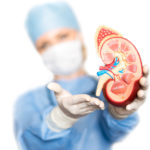By David Blyweiss, M.D., Advanced Natural Wellness
Are you often tired for absolutely no reason? Do you often suffer from cold hands and feet, even when the temperature is soaring? Does that excess weight refuse to budge no matter how little you eat or how much you exercise?
If you answered yes to any of these questions, you might be part of a growing epidemic.
It’s estimated that 59 million Americans have a thyroid problem, but the majority don’t even know it yet. The thyroid, a butterfly-shaped gland located in the neck, is the master gland of metabolism.
MD Exposes the Hidden Danger to Your Eyes

When your eyesight starts to fail, it's a real problem. Suddenly you can't go to the grocery store... you can't get to the doctor if you have an emergency... you can't meet your friends for dinner…
Your "regular" doctor doesn't have time to keep up with the latest research. And the same goes for eye doctors. They go to school to learn how to fit you for glasses and contacts, but have no way of preventing the damage and loss of eyesight that threatens your freedom and independence.
Let me show you something that explains a LOT about how your eyes work.
In my FREE Special Report, I'll show you a HUGE, untapped resource for your eyes that safely and naturally restores clear, effortless eyesight.
Click here to get started...
And when your thyroid doesn’t function, it can affect every aspect of your health, and in particular, weight and energy levels.
You may have low thyroid function if you experience more than one of these symptoms:
- Muscle and joint pain
- Hair or skin changes
- Bowel problems
- High cholesterol
- Depression and anxiety
- Inability to tolerate cold
- Trouble concentrating
- Low sex drive
- Weight gain
- Unexplained fatigue
- Swelling of the arms, hands, legs, and feet, and facial puffiness, particularly around the eyes.
Unfortunately, getting your thyroid activity accurately measured can be a medical minefield. Your doctor may order the wrong tests, misinterpret the results, or prescribe an ineffective treatment.
Are You Suffering From...
- Love handles and a pot belly
- Romance that isn't what it used to
- Forgetfulness and inattention
- Low (or no) strength and endurance
- A sex drive that's shifted into neutral...or worse
If so...you may have Mature Male Burnout. Click here to discover more about this unique condition and what you can do about it.
Even if your tests indicate that your thyroid function is in the normal range, this glands activity still might not be up to par. After all, there’s a big difference between what the lab thinks is normal and what’s optimal for human health. Since undiagnosed thyroid problems can dramatically increase your risk of obesity, heart disease and a host of other health problems, it’s important to give your thyroid the support it needs.
Even if the tests come back negative, if I suspect a patient is suffering from borderline low thyroid function—usually after an extensive physical exam—I start them on the following supplement program. Your body needs all 3 of these nutrients to make and use thyroid hormones.
As always, ask your doctor to test the level of these and other critical nutrients and minerals to know exactly how much you need and for how long.
L-tyrosine. This amino acid forms part of the chemical foundation of thyroid hormones. It’s also important for neurotransmitters like dopamine and adrenaline. I recommend taking 500 mg of L-tyrosine as soon as you wake up in the morning and at least 15 minutes before you eat or drink anything. A word of warning though: If you have high blood pressure, monitor your blood pressure after taking L-tyrosine because it may increase it. Stop taking L-tyrosine if you have an unsafe increase in blood pressure.
Iodine. This essential mineral also forms part of the foundation of thyroid hormones—T4 contains four iodine atoms, and T3 contains three.1 Multivitamins and kelp supplements don’t contain enough iodine to help normalize thyroid function. Making matters worse, most of us don’t get the iodine we need from our diet. Iodized salt is getting a bad rap from proponents of a low-salt diet. What’s more, bromine has replaced iodine in commercially prepared bread. And chlorinated sucrose sweeteners like Splenda and fluoridated water and toothpaste knocks iodine off your thyroid receptor sites. Correcting this deficiency may require that you take 5–10 mg of iodine daily for a couple of months before reducing the amount.
Selenium. You need selenium to make enzymes called deiodinases, which convert T4 to T3 thyroid hormones.2 But too much selenium can be just as harmful as too little. That’s why I recommend taking no more than 200 mcg of selenium daily. As a general rule, that’s about what you’ll find in most multivitamin supplements.
Multivitamin/multimineral. Speaking of a multivitamin, be sure to take one since other nutrients like B-complex vitamins and zinc also help make thyroid hormones.
If you’re thyroid isn’t working optimally, what you eat matters too. Some foods support normal thyroid activity—especially seafood and seaweed, which are loaded with iodine; Brazil nuts, which are the richest natural source of selenium; and whole proteins such as fish, chicken, turkey, and eggs, which contain L-tyrosine.
On the other hand, some foods contain substances that interfere with normal thyroid activity. And unfortunately, many of them are foods that would otherwise be good for you. These include cruciferous vegetables, soy, kohlrabi, mustard greens, radishes, rutabaga, spinach, turnips, pine nuts, peanuts, and millet. Cooking generally inactivates these substances, but if your thyroid activity is significantly low, it may be best to minimize your intake or avoid these foods until you’ve corrected the problem.
References:
- Laurberg P. The Danish investigation on iodine intake and thyroid disease, DanThyr: status and perspectives. European Journal of Endocrinology. 2006;155:219-228.
- Duntas LH. Selenium and the thyroid: a close-knit connection. Journal of Clinical Endocrinology & Metabolism. 2010;95:5180-5188






